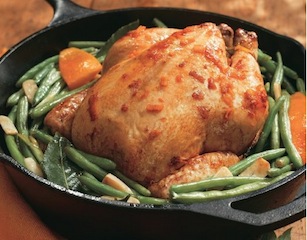Safe Cookware

Does Stainless Steel Leach Chemicals?
There is a lot of information in the blogosphere about health and safety in cookware, but when a client asked whether stainless steel leached dangerous chemicals, I was unable to find a quick answer to her question. I decided to look into the issue of safe cookware myself.
In one 2013 study scientists tested the leaching of nickel and chromium into foods cooked in stainless steel pans. The study tested stainless steel leaching into tomato sauce over periods of 2 to 20 hours. The findings were as follows:
- Longer durations of cooking increased leaching.
- New stainless steel leached more than pans that had been used prior to testing.
- The 10th cooking cycle resulted in an average of 88 μg of nickel and 86 μg of chromium leached per 126 g serving of tomato sauce.
Here is why I’m not convinced we should be concerned that stainless steel is leaching dangerous chemicals:
- Humans are estimated to ingest an average of 150 to 900 μg of nickel per day. The Tolerable Upper Intake Level (UL) of nickel is 1000 μg per day.
- A single dose of 3000 μg nickel can cause allergic dermatitis, but results of the study showed leaching levels far below this limit.
- According to the National Institute of Health (NIH), safe dietary intake of chromium for adults and adolescents is 25 to 45 μg per day. However, there are no adverse effects to high intake of chromium, so there is no Tolerable Upper Intake Level (UL) set .
- The chromium in solid stainless is not to be confused with Chromium 6. Chromium 6 (hexavalent chromium) is a carcinogen that is given off in fumes during the welding of stainless steel, but our kitchen stoves cannot cause stainless steel to break down to this level.
Because Nickel concentrations were found to be far below Upper Intake Levels, I am not sufficiently concerned by the leaching of stainless steel. And if chromium does not cause adverse health effects sufficient to set a Tolerable Upper Intake Level, again, I am not concerned about it.
In discussing safe cookware, below is some additional information about different types of cookware and possible health concerns.
Options for Safe Cookware
Non-stick Cookware
Avoid all non-stick coatings if possible, which are made with Perfluorocarbons. Perfluorocarbons are persistant, bioaccumulative, and toxic (PBTs), and Teflon is a suspected carcinogen. If you must cook with non-stick, at the very least, make sure the surface of your pan is not scratched. Scratched pans increase leaching of the non-stick chemicals into food. Whether scratched or not, normal cooking temperatures cause PFCs to vaporize, hence why they are known to kill domestic birds.
Cast Iron Cookware
Cooked foods absorb iron content in cast iron pans. Based on Daily Recommended Intake (RDA) for Iron, this is a good thing for teenage girls and women who are menstruating (both need 15 mg iron per day) and pregnant women (need 30 mg iron per day), but not necessarily for post-menopausal women or adult men (10 mg iron per day) who get enough iron through their diet. Children do not generally need iron supplementation either, needing 10 mg or less per day.

Cast iron cookware does add iron content to food.
Iron “overload” (hemochromatosis) in adults is a serious condition, but it is usually caused by an underlying hereditary condition in which a person’s iron absorption is abnormally high. (Because the symptoms associated with iron overload are similar to those associated with iron deficiency, it is best to check with your doctor to find out your iron levels before concluding whether you need more or less in your diet). In one study, cast iron added 7 mg iron to acidic foods and 3-4 mg to eggs, so if you are in the low iron-need range, it is definitely worth factoring in the added iron from the pan.
Copper Coated Cookware
Uncoated copper cookware is highly toxic, but copper coated with tin or stainless steel is considered relatively safe cookware. Copper pans that have worn coatings should be re-coated. (See stainless steel comments for toxicity concerns). Tin is non-reactive and rarely toxic to humans, so it is a relatively safe coating for copper pans. Also of note, however: tin combined with carbon (organotins) are used in making plastics, food packages, pesticides, paints, and wood preservatives, and these combinations are highly toxic. Tin is also a conflict mineral–it is mined in eastern Congo and its trade contributes to violence in the region.
Glazed Iron Cookware
The primary concern with glazed iron would the presence of lead in the glaze, but for instance, Le Creuset glazes are lead free, and are therefore considered safe cookware. Inexpensive or imported cookware should only be purchased only with a lead-free guarantee.



